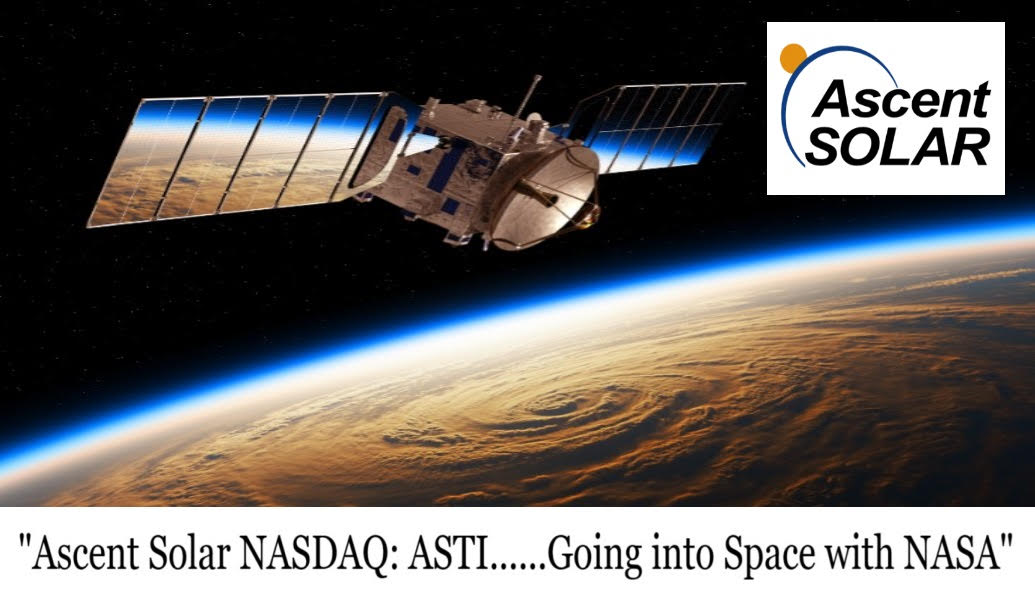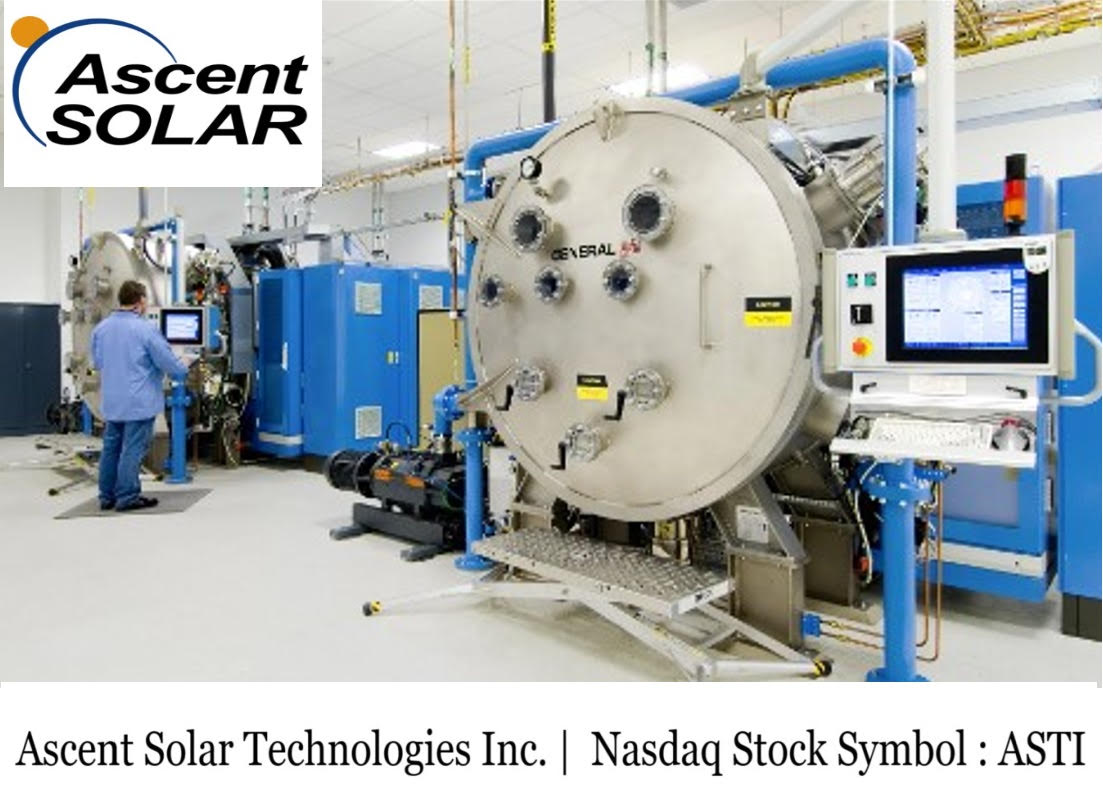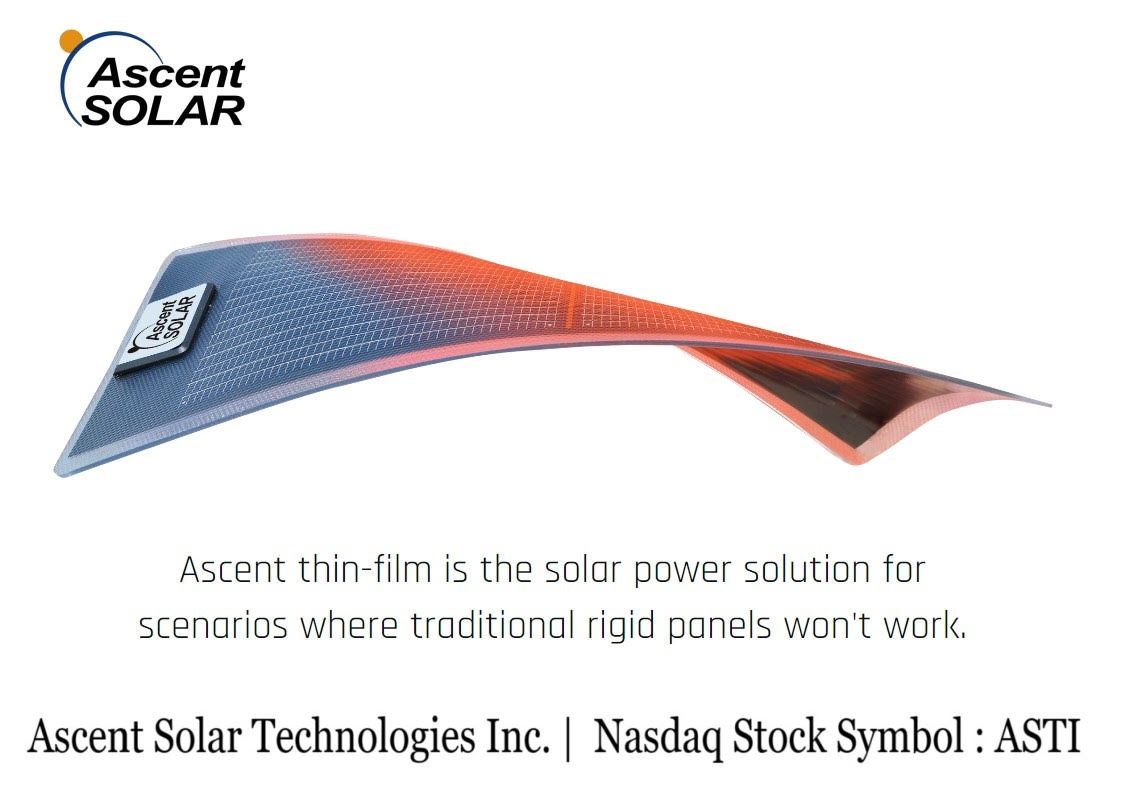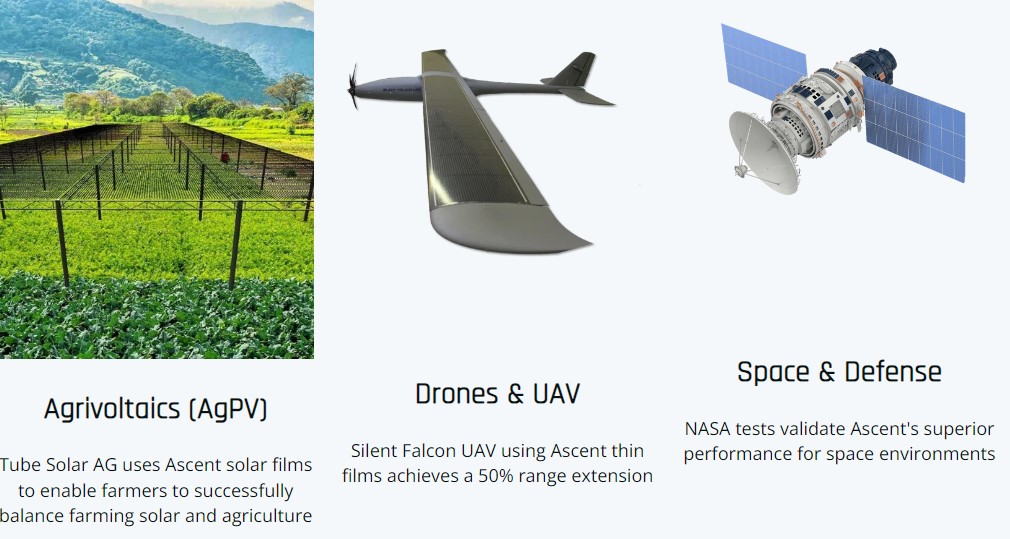Trending...
- Colorado Springs: Catch the fun at the Pikes Peak – America's Mountain Youth Fishing Derby
- Colorado: Creating Rural Jobs: Mytikas Manufacturing Bringing 170 New Jobs to Fremont County
- City of Colorado Springs announces cost-savings measures in anticipation of 2026 budget shortfall
Ascent Solar Technologies, Inc. (N A S D A Q: ASTI) $ASTI has a Collaborative Agreement Notice with NASA to Advance Development of Thin-Film PV Power Beaming Capabilities
THORNTON, Colo. - ColoradoDesk -- Provider of Innovative, High-Performance, Flexible Thin-Film Solar Panels for Environments Where Wass, Performance, Reliability and Resilience Matter.
Successful Applications in Space Missions, Aircraft, Agrivoltaic Installations, Industrial/Commercial Construction and Consumer Goods.
Research and Development Center and 5-MW Nameplate Production Facility Strategically Located in Thornton, Colorado.
Multiple Strategic Partners in the Space Market, Including a Major Defense Contractor, Multiple Deployable Technology Companies and a Satellite Company.
Teaming Agreement to Supply US-Based Defense Solutions Provider with Thin-Film Solar Technology for Orbital Application.
Ascent Solar Technologies Enters Collaborative Agreement Notice with NASA to Advance Development of Thin-Film PV Power Beaming Capabilities.
Record New Efficiency of 15.7% at Production Scale for CIGS Solar Technology.
Ascent Solar Technologies, Inc. (N A S D A Q: ASTI) is backed by 40 years of R&D, 15 years of manufacturing experience, numerous awards, and a comprehensive IP and patent portfolio. ASTI is a leading provider of innovative, high-performance, flexible thin-film solar panels for use in environments where mass, performance, reliability and resilience matter. ASTI photovoltaic (PV) modules have been deployed on space missions, multiple airborne vehicles, agrivoltaic installations, in industrial/commercial construction as well as an extensive range of consumer goods, revolutionizing the use cases and environments for solar power. The ASTI research and development center and 5-MW nameplate production facility is strategically located in Thornton, Colorado.
Teaming Agreement to Supply US-Based Defense Solutions Provider with Thin-Film Solar Technology for Orbital Application
On June 27th ASTI announced today a Teaming Agreement to supply a US-based defense solutions provider with its cutting edge, thin-film solar technology solutions for upcoming orbital applications and future missions.
ASTI is able to offer mission-optimized solar array solutions using its CIGS PV product line that has been developed with spaceflight heritage. These high-maturity CIGS PV products are produced domestically in the ASTI 5 MW facility in Thornton, CO, enabling array deliveries in just six-to-eight weeks. In contrast, most competitors are unable to meet tight delivery deadlines, often requiring lead times of nine-to-twelve months. Earlier this year, ASTI received several orders for spaceflight hardware assemblies that are on schedule to be completed and delivered this summer.
More on Colorado Desk
Ascent Solar Technologies Enters Collaborative Agreement Notice with NASA to Advance Development of Thin-Film PV Power Beaming Capabilities
THORNTON, Colo., June 26, 2025 -- Ascent Solar Technologies (N a s d a q: ASTI) ("Ascent" or the "Company"), the leading U.S. innovator in the design and manufacture of featherweight, flexible, and durable CIGS thin-film photovoltaic (PV) solutions, announced today that the company is commencing work on a Collaborative Agreement Notice (CAN) with NASA Marshall Space Flight Center (MSFC) and support from NASA Glenn Research Center (GRC) to efficiently advance capabilities for receiving beamed power using CIGS PV modules.
The CAN program targets rapid iterative development to mature commercial products for enabling mission architectures to include beamed power. The public-private partnership includes Ascent contributing design and prototyping services with NASA providing technical subject matter expertise and test services through combined MSFC & GRC efforts. This 12-month technology maturation will result in commercial products being made available for distributed space power infrastructure, drastically lowering the cost, complexity and risk of NASA missions.
Launched in 2023, NASA's Psyche Mission has demonstrated deep space laser communications across 19 million miles of space, validating the efficacy of tight-beaming technologies over vast distances. Bench-testing conducted by NASA MSFC in 2024 demonstrated receiving beamed power using Ascent's commercial-off-the-shelf (COTS) products as a preceding validation of the technology prior to the CAN award.
The CAN is evaluating the ability of Ascent's CIGS PV modules to generate power while illuminated by energy-dense beams of light, with goals to convert more usable power from the equivalent of tens of Earth's Sun. The ability to remotely receive 10x more power on-demand while using the same PV cells tasked with collecting sunlight can significantly reduce solar array mass and volume required to meet mission power needs. In practice, this suggests that beamed-power architectures can lead to reductions of both spacecraft mass and volume budgets. These size efficiencies will result in agency payloads proportionally increasing relative to the spacecraft as a whole, thus allowing the prioritization of more technology, science and exploration within limited mission budgets.
Planetary missions require advanced surface mobility logistics and depend on power generation subsystems that comprise a substantial proportion of the landed downmass. It is here where Ascent technology poses a potential solution for reducing spacecraft power system mass and volume needs, creating a significant impact on the overall mission.
The CAN's goals include increasing the array power output while lengthening the operational duty cycles to verify that improvements to this emerging technology can help enable NASA to effectively and efficiently achieve the agency's Commercial Lunar Payload Services (CLPS) missions, Artemis campaign to the Moon, and planetary science objectives. This includes enabling surviving the lunar night as well as powering remote access to areas of scientific interest such as cold traps and permanently shadowed regions on the Moon (PSRs) where water, the potential key to lunar in-situ resource utilization (ISRU), is believed to be located in high concentrations. Ultimately, this could lead to an order of magnitude reduction in the downmass required to access expensive space exploration and science mission destinations. The going rate for robotic landers on the Moon is between 6 & 7-figures per kilogram delivered to the lunar surface, equating to upwards of tens of millions of potential savings per lander mission.
More on Colorado Desk
"This collaboration with NASA further bolsters our longstanding belief that the unique capabilities of thin-film solar technology will play an integral role in overcoming the challenges of reliably converting solar energy and also receive beamed power in a breadth of harsh space environments," said Paul Warley, CEO of Ascent Solar Technologies. "Through our work together, we plan to bring an even more capable product line to market that will reduce mission costs and complexities while improving PV efficiency, making our technology a crucial piece of future space missions."
This cross-NASA-center teaming is demonstrative of rallying together with commercial partners to achieve the agency's broader Lunar program goals. Beamed power stands to allow NASA program dollars to accomplish more at a fraction of the cost. With 55 countries having signed the Artemis Accords since 2020, the establishment of critical Lunar infrastructure with less resources required facilitates achieving more together with international partners.
Achievement of Record New Efficiency of 15.7% at Production Scale for CIGS Solar Technology
On June 9th ASTI announced that its thin-film CIGS technology reached record efficiency at 15.7% (AM0) at production scale. This achievement aligns with the previously announced ASTI 2025 strategy which aimed to continue improving upon its thin-film PV's material quality, technological efficiency and production design optimization to increase the applicability of the technology in the space market.
Using the Titan™, a module approximately one square foot in size, ASTI can now produce a formidable 15.7 watts in power per unit. These modules are approximately 0.03mm in thickness and just over eight grams in weight, possess an impressive power density of 1960W/kg before encapsulation.
ASTI engineering and production teams have consistently achieved increases in device efficiency and overall performance since September 2023. In the last 18 months, ASTI has reached significant milestones in efficiency testing, with the latest achievement of 15.7% representing a significant increase from Q1 2024:
(Note: Power generation figures reflect STC conditions and AM0)
"These continued efficiency improvements for our CIGS arrays are the direct result of our U.S.-based manufacturing team's tireless focus on process improvement and advanced device engineering," said Paul Warley, CEO of ASTI. "The jump in device efficiency we've experienced over the past two years has dramatically enhanced our technology's readiness for the space market, positioning it as an ideal solar material choice for satellite power systems and other spacecraft."
For more information on $ASTI visit: https://www.ascentsolar.com or https://compasslivemedia.com/asti/For more information on $ASTI visit:
Media Contact
Company Name: Ascent Solar Technologies, Inc (N a s d a q: ASTI)
Contact Person: Paul Warley, CEO
Email: sales@ascentsolar.com
Phone: (720) 872-5000
Country: United States
Website: https://www.ascentsolar.com
DISCLAIMER: https://corporateads.com/disclaimer/
Disclosure listed on the CorporateAds website
Successful Applications in Space Missions, Aircraft, Agrivoltaic Installations, Industrial/Commercial Construction and Consumer Goods.
Research and Development Center and 5-MW Nameplate Production Facility Strategically Located in Thornton, Colorado.
Multiple Strategic Partners in the Space Market, Including a Major Defense Contractor, Multiple Deployable Technology Companies and a Satellite Company.
Teaming Agreement to Supply US-Based Defense Solutions Provider with Thin-Film Solar Technology for Orbital Application.
Ascent Solar Technologies Enters Collaborative Agreement Notice with NASA to Advance Development of Thin-Film PV Power Beaming Capabilities.
Record New Efficiency of 15.7% at Production Scale for CIGS Solar Technology.
Ascent Solar Technologies, Inc. (N A S D A Q: ASTI) is backed by 40 years of R&D, 15 years of manufacturing experience, numerous awards, and a comprehensive IP and patent portfolio. ASTI is a leading provider of innovative, high-performance, flexible thin-film solar panels for use in environments where mass, performance, reliability and resilience matter. ASTI photovoltaic (PV) modules have been deployed on space missions, multiple airborne vehicles, agrivoltaic installations, in industrial/commercial construction as well as an extensive range of consumer goods, revolutionizing the use cases and environments for solar power. The ASTI research and development center and 5-MW nameplate production facility is strategically located in Thornton, Colorado.
Teaming Agreement to Supply US-Based Defense Solutions Provider with Thin-Film Solar Technology for Orbital Application
On June 27th ASTI announced today a Teaming Agreement to supply a US-based defense solutions provider with its cutting edge, thin-film solar technology solutions for upcoming orbital applications and future missions.
ASTI is able to offer mission-optimized solar array solutions using its CIGS PV product line that has been developed with spaceflight heritage. These high-maturity CIGS PV products are produced domestically in the ASTI 5 MW facility in Thornton, CO, enabling array deliveries in just six-to-eight weeks. In contrast, most competitors are unable to meet tight delivery deadlines, often requiring lead times of nine-to-twelve months. Earlier this year, ASTI received several orders for spaceflight hardware assemblies that are on schedule to be completed and delivered this summer.
More on Colorado Desk
- NIUFO Positions Platform for European Market Entry with MiCA-Aligned Infrastructure Development
- Colorado Springs: City Council Invites Community Engagement: Serve on the Parks, Recreation, and Cultural Services Advisory Board
- Lasting Relief from Low Back Pain in Boulder: Mend Colorado Delivers Evidence-Based Therapy for Active Lifestyles
- Suerte Blanco Tasting Notes: Explore Our New Sensory Guide
- Teamsters Demand Fair Deal at Ralphs
Ascent Solar Technologies Enters Collaborative Agreement Notice with NASA to Advance Development of Thin-Film PV Power Beaming Capabilities
THORNTON, Colo., June 26, 2025 -- Ascent Solar Technologies (N a s d a q: ASTI) ("Ascent" or the "Company"), the leading U.S. innovator in the design and manufacture of featherweight, flexible, and durable CIGS thin-film photovoltaic (PV) solutions, announced today that the company is commencing work on a Collaborative Agreement Notice (CAN) with NASA Marshall Space Flight Center (MSFC) and support from NASA Glenn Research Center (GRC) to efficiently advance capabilities for receiving beamed power using CIGS PV modules.
The CAN program targets rapid iterative development to mature commercial products for enabling mission architectures to include beamed power. The public-private partnership includes Ascent contributing design and prototyping services with NASA providing technical subject matter expertise and test services through combined MSFC & GRC efforts. This 12-month technology maturation will result in commercial products being made available for distributed space power infrastructure, drastically lowering the cost, complexity and risk of NASA missions.
Launched in 2023, NASA's Psyche Mission has demonstrated deep space laser communications across 19 million miles of space, validating the efficacy of tight-beaming technologies over vast distances. Bench-testing conducted by NASA MSFC in 2024 demonstrated receiving beamed power using Ascent's commercial-off-the-shelf (COTS) products as a preceding validation of the technology prior to the CAN award.
The CAN is evaluating the ability of Ascent's CIGS PV modules to generate power while illuminated by energy-dense beams of light, with goals to convert more usable power from the equivalent of tens of Earth's Sun. The ability to remotely receive 10x more power on-demand while using the same PV cells tasked with collecting sunlight can significantly reduce solar array mass and volume required to meet mission power needs. In practice, this suggests that beamed-power architectures can lead to reductions of both spacecraft mass and volume budgets. These size efficiencies will result in agency payloads proportionally increasing relative to the spacecraft as a whole, thus allowing the prioritization of more technology, science and exploration within limited mission budgets.
Planetary missions require advanced surface mobility logistics and depend on power generation subsystems that comprise a substantial proportion of the landed downmass. It is here where Ascent technology poses a potential solution for reducing spacecraft power system mass and volume needs, creating a significant impact on the overall mission.
The CAN's goals include increasing the array power output while lengthening the operational duty cycles to verify that improvements to this emerging technology can help enable NASA to effectively and efficiently achieve the agency's Commercial Lunar Payload Services (CLPS) missions, Artemis campaign to the Moon, and planetary science objectives. This includes enabling surviving the lunar night as well as powering remote access to areas of scientific interest such as cold traps and permanently shadowed regions on the Moon (PSRs) where water, the potential key to lunar in-situ resource utilization (ISRU), is believed to be located in high concentrations. Ultimately, this could lead to an order of magnitude reduction in the downmass required to access expensive space exploration and science mission destinations. The going rate for robotic landers on the Moon is between 6 & 7-figures per kilogram delivered to the lunar surface, equating to upwards of tens of millions of potential savings per lander mission.
More on Colorado Desk
- One Park Financial Earns Great Place to Work® Certification for the Eighth Time
- Furniture Rental in Aspen Colorado | Luxury Rentals by BOHO Design Rentals
- Open Art Call | The Art of Artificial Intelligence | Copenhagen
- Premieres of 10th Annual NY Dog Film Festival & 8th Annual NY Cat Film Festival on Sunday, October 26, 2025 to Benefit Animal Lighthouse Rescue
- $20 Price Target in Noble Capital Research Report as Deal is Signed for NFL Yearbook Advertising Across 25 Stadiums for AI Powered Sports Leader $SEGG
"This collaboration with NASA further bolsters our longstanding belief that the unique capabilities of thin-film solar technology will play an integral role in overcoming the challenges of reliably converting solar energy and also receive beamed power in a breadth of harsh space environments," said Paul Warley, CEO of Ascent Solar Technologies. "Through our work together, we plan to bring an even more capable product line to market that will reduce mission costs and complexities while improving PV efficiency, making our technology a crucial piece of future space missions."
This cross-NASA-center teaming is demonstrative of rallying together with commercial partners to achieve the agency's broader Lunar program goals. Beamed power stands to allow NASA program dollars to accomplish more at a fraction of the cost. With 55 countries having signed the Artemis Accords since 2020, the establishment of critical Lunar infrastructure with less resources required facilitates achieving more together with international partners.
Achievement of Record New Efficiency of 15.7% at Production Scale for CIGS Solar Technology
On June 9th ASTI announced that its thin-film CIGS technology reached record efficiency at 15.7% (AM0) at production scale. This achievement aligns with the previously announced ASTI 2025 strategy which aimed to continue improving upon its thin-film PV's material quality, technological efficiency and production design optimization to increase the applicability of the technology in the space market.
Using the Titan™, a module approximately one square foot in size, ASTI can now produce a formidable 15.7 watts in power per unit. These modules are approximately 0.03mm in thickness and just over eight grams in weight, possess an impressive power density of 1960W/kg before encapsulation.
ASTI engineering and production teams have consistently achieved increases in device efficiency and overall performance since September 2023. In the last 18 months, ASTI has reached significant milestones in efficiency testing, with the latest achievement of 15.7% representing a significant increase from Q1 2024:
- Q3 2023: 11.6 watts
- Q4 2023: 13.3 watts
- Q1 2024: 14.0 watts
- Q2 2025: 15.7 watts
(Note: Power generation figures reflect STC conditions and AM0)
"These continued efficiency improvements for our CIGS arrays are the direct result of our U.S.-based manufacturing team's tireless focus on process improvement and advanced device engineering," said Paul Warley, CEO of ASTI. "The jump in device efficiency we've experienced over the past two years has dramatically enhanced our technology's readiness for the space market, positioning it as an ideal solar material choice for satellite power systems and other spacecraft."
For more information on $ASTI visit: https://www.ascentsolar.com or https://compasslivemedia.com/asti/For more information on $ASTI visit:
Media Contact
Company Name: Ascent Solar Technologies, Inc (N a s d a q: ASTI)
Contact Person: Paul Warley, CEO
Email: sales@ascentsolar.com
Phone: (720) 872-5000
Country: United States
Website: https://www.ascentsolar.com
DISCLAIMER: https://corporateads.com/disclaimer/
Disclosure listed on the CorporateAds website
Source: CorporateAds
0 Comments
Latest on Colorado Desk
- Colorado: Host Your Holiday Celebration at The Governor's Residence at Boettcher Mansion
- Denver LASIK & Vision Correction Leader 20/20 Institute Sets New Standard for Concierge-Level Eye Surgery in Colorado
- New Leadership and Renovations Usher in Next Chapter for Sunrise Manor
- Who Will Win the 2025 WNBA Finals? OddsTrader Shares Live Betting Odds and Projections
- Geeks5g Creative Marketing: The Powerhouse Behind Business Growth
- Governor Polis and Colorado State Demography Office Release Analysis on the Current State of Colorado's Housing Shortfall
- Colorado: Lt. Governor Dianne Primavera Honored with National Award for Leadership in Service
- Agemin Unveils Breakthrough AI Model for Biometric Age Estimation, Setting New Standards in Online Child Safety
- InventHelp Inventor Develops Portable Hybrid Grow System (DNV-640)
- Strategic Partnerships with Defiant Space Corp and Emtel Energy USA Powerfully Enhance Solar Tech Leader with NASA Agreements: Ascent Solar $ASTI
- 120% Revenue Surge with Four Straight Profitable Quarters Signal a Breakout in the Multi-Billion Dollar Homebuilding Market: Innovative Designs $IVDN
- Leading Venture Capital Firms Recognize Wzzph Exchange's Technical Architecture and Security Framework as Industry Benchmark
- DivX Unveils Major DivX Software Update: Seamless Video Sharing and Customizable Playback Now Available
- Nespolo Mechanical Helps New Mexico Families Save Thousands on Heating Costs This Fall
- Leading Digital Finance Platform YNQTL Launches Revolutionary Web3 Digital Asset Trading Platform
- IDCXS Addresses Crypto Trading Pain Points with 2 Million TPS Processing and Multi-Layer Security Architecture
- Bridging Traditional Finance and Web3 Innovation: BLFCW Announces Strategic Vision for Regulated Web3 Economy
- NKSCX Responds to "Coordinated Smear Campaign" as Anonymous Critics Emerge Following Regulatory Milestones
- Broadway Gala Honored Also an Italian
- $ONI Listed on MEXC as ONINO Powers Europe's Tokenization Engine Into Public Platform Launch





